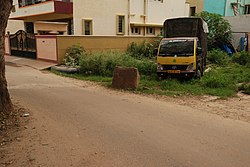Prehistoric Beginnings
The region surrounding Kodigehalli has been inhabited since prehistoric times. he Directorate of Census Operations completed its decadal Census recently.[ when? ] Archaeological discoveries in nearby areas such as Jalahalli, Siddapur, and Gavipura have revealed Stone Age tools dating from 2000 to 1000 BCE. During the Middle Stone Age (circa 4000 BCE), evidence of human habitation was found at Jalahalli, Sudasandra, Siddhapura, and Jadigenahalli, highlighting the region's role as a cradle of early human activity.
In the Iron Age (circa 1000 BCE), burial grounds were established in nearby localities, such as Koramangala and Chikkajala, further indicating the area's long-standing significance. Additionally, the discovery of Roman coins from the reigns of emperors Augustus, Tiberius, and Claudius in places like Yeshwantpur and HAL points to early trade and cultural exchanges with distant civilizations.
City of Boiled Beans Connection
Kodigehalli holds a significant place in the historical and folkloric origins of "Bengaluru", often referred to as the "City of Boiled Beans." The name "Bengaluru" is believed to derive from the Kannada term Benda-Kaal-Ooru, meaning "Town of Boiled Beans." This name is linked to a fascinating tale from the reign of the Hoysala king, Veera Ballala II.
According to legend, while on a hunting expedition, King Veera Ballala II became lost in the dense forests near what is now Kodigehalli. Separated from his retinue, the king was exhausted and on the verge of collapse due to hunger and thirst. In his search for help, he came across a humble hut. The elderly woman who lived there, noticing the king's dire condition, offered him boiled beans and water—the only provisions she had.
This simple yet profound act of kindness deeply moved the king. As a gesture of gratitude, he named the area Benda-Kaal-Ooru, or "Boiled Beans Town." Over the centuries, this name evolved into Bengaluru, the vibrant capital of Karnataka.
Halé Bengaluru and the Ganga Era
Kodigehalli is closely linked to the ancient settlement of Halé Bengaluru (Old Bangalore)., [1] which was mentioned in inscriptions from the Ganga dynasty (circa 9th century CE). These records identify Halé Bengaluru as a small hamlet in the area, believed to be near modern Kodigehalli. The locality remained significant during the subsequent dynasties due to its strategic location and agricultural fertility.
Rock Inscriptions and Hero Stones
Kodigehalli is home to historically significant rock inscriptions, including hero stones that record notable celestial events such as solar eclipses. These inscriptions, etched in stone, provide insights into the region's cultural and astronomical knowledge during ancient times. The hero stones are a testament to the area's rich heritage, reflecting both valor and scientific awareness of early civilizations.
Connection to Kempe Gowda and the Founding of Bengaluru
The historical prominence of Kodigehalli grew during the 16th century when Kempe Gowda I established Bengaluru as a fortified town in 1537 CE. The name "Bengaluru" is said to have been inspired by Halé Bengaluru, as Kempe Gowda's mother and wife hailed from this village near Kodigehalli. This act intertwined the fate of Kodigehalli with the city's foundation, symbolizing its historical importance.
Kodigehalli as a Royal Gift
The name Kodigehalli itself reflects its regal past. The term Kodige translates to "gift" in Kannada, commemorating the land granted by King Veera Ballala of the Hoysala dynasty to two loyal brothers, Byregowda and Bacchegowda. The brothers were rewarded for their bravery in retrieving two of the king's prized horses that had escaped. This event not only gave the locality its name but also cemented its role as a vital area under royal patronage.
Cultural and Historical Evolution
Through the Vijayanagara period and later under Mysore rulers, Kodigehalli remained an agricultural and administrative hub. Its proximity to the Hebbal Lake, one of the oldest man-made lakes in Bengaluru, added to its significance as a fertile and resource-rich area. The lake also supported the agrarian lifestyle of the Kodigehalli community.
Legacy and Importance
Kodigehalli stands as a testament to Bengaluru's long and layered history, from the Stone Age to the modern era. Its evolution mirrors that of Bengaluru itself, making it a vital part of the city's cultural and historical heritage.




